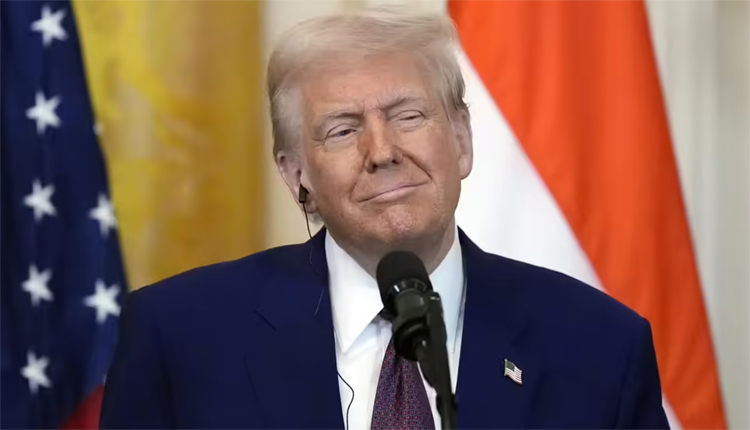Washington: US President Donald Trump has significantly escalated trade tensions by imposing a 25% tariff on Indian goods. Starting August 7, 2025, the total import tax will be 50%, and businesses have 21 days to prepare for the change. This action, meant to push India to stop buying crude oil from Russia, has angered officials in New Delhi.
The Indian government says the move is really unfortunate and claims the US and Europe are applying unfair double standards. Key export areas like textiles, leather, and seafood are bracing for big losses, but India is standing its ground, defending its energy plans and pointing out that Western countries also trade a lot with Russia.
A Penalty Aimed At Indian Exports
President Trump’s order states that India’s ongoing purchase of Russian crude oil is a primary reason for the increased tariff, as it supports Russia’s war in Ukraine. The change is likely to hit India’s $87 billion export market to the US. Industries like textiles, leather, and seafood will be most hurt. These sectors support millions of jobs, especially in small and medium-sized businesses.
The Federation of Indian Export Organisations (FIEO) called the move extremely shocking, warning that up to 55% of India’s exports to the US could face serious price disadvantages.
However, some products like medicines, electronics and energy are exempt, offering a bit of relief. Still, experts warn that if the tariffs stick around, they could knock as much as 0.4% off India’s GDP growth.
India’s Oil Plan: Guarding Against Inflation
India’s strong reaction shows how important it is for it to import Russian oil. Russian oil made up 38% of India’s total crude imports by 2025. Before the Ukraine conflict in 2022, it was just 0.2%. This ‘Oil Defence’ plan, started after the Iran-Israel conflict, has been key in keeping domestic fuel prices steady and protecting Indian consumers from global oil price increases. By buying cheaper Russian crude, India has saved billions of dollars, kept inflation down, and made sure it has enough energy for its 1.4 billion people.
The Ministry of External Affairs (MEA) defended this approach, stating, “Our imports depend on market conditions and the need to supply energy at reasonable prices for our people. It is really unfortunate that the US is targeting India for doing things that other countries also do in their interest.” The ministry’s statement stresses that India’s oil trade follows international rules, unlike the stronger restrictions on countries like Iran or Venezuela.
Western Hypocrisy In The Spotlight
India has called out the US and the European Union (EU) for taking a stand that doesn’t match their actions. According to the Centre for Research on Energy and Clean Air (CREA), the EU still relies heavily on Russian energy. In 2025, it accounted for 37% of Russia’s pipeline gas exports and 50% of its liquefied natural gas (LNG). Europe’s total trade with Russia reached €67.5 billion in 2024, despite a 6% reduction in crude oil imports. This is way more than India’s $68.7 billion trade with Moscow. The US also continues to import Russian uranium, palladium, fertilisers, and chemicals, yet it is singling out India for criticism.
China, which buys the most Russian crude (47%) and pipeline gas (29%) in 2025, hasn’t faced similar tariffs. This raises concerns about selective targeting. “It’s telling that those criticising India are themselves heavily involved in trade with Russia,” said an MEA spokesperson, who accused the West of putting unjustified and unreasonable pressure on India.
A Geopolitical Chess Game
Experts see the US tariff increase as more than just a trade disagreement; it is a political move to limit India’s freedom to act on its own. India’s refusal to give in to Western pressure, along with its strong defence of its own interests, has annoyed the US, especially as New Delhi strengthens its ties with Russia and gets ready for Prime Minister Narendra Modi’s coming visit to China. The tariffs suggest a shift from the friendly relations of Modi’s earlier meetings with Trump, including the 2019 ‘Howdy Modi’ rally in Texas.
Experts warn that the move could push India closer to BRICS allies like China and Russia and potentially reshape global trade relationships. “The West wants India to fall in line, but India’s independent foreign policy is something that can’t be negotiated,” said trade economist Biswajit Dhar.
India’s Firm Position
With 21 days before the higher tariff goes into effect, India is looking into diplomatic and economic measures. These measures include financial aid, such as interest subsidies for exporters. The government has suggested it will avoid immediate retaliation, focusing instead on protecting its farmers, small businesses, and energy supply. As Prime Minister Modi repeated at a recent conference, “India will never compromise on the welfare of its farmers, fishers, and dairy producers.”
As global markets keep a close watch, India’s firm position highlights the West’s selective anger. It casts doubt on the notion that New Delhi is the antagonist in the Russia oil trade. The next few weeks will be a test of India’s strength and ability to deal with this high-stakes trade war.



Comments are closed.